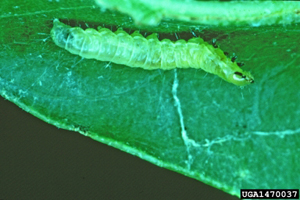DACF Home → Bureaus & Programs → Maine Forest Service → Forest Health & Monitoring → Forest Pest Index → Oak Leaf Tier
OAK LEAF TIER
Croesia semipurpurana (Kearfoot)
Symptoms and Damage
The oak leaf tier is a pest of oaks throughout the Northeastern United States and Canada. In Maine this insect occurs primarily on red oak and has infested thousands of acres in the Central Maine area in recent years. Foliage of infested trees tends to be somewhat ragged, sparse, distorted, and rolled up due to the feeding damage of the larva. Normally trees defoliated by this insect can survive 2 and possibly 3 years of successive defoliation before twig and branch mortality begin to appear. In most areas it is rare to have more than 2 successive years of heavy defoliation by this pest before populations collapse. Most trees refoliate, however, the second crop of leaves is usually yellower and somewhat stunted. It is often the nuisance caused by larvae as they spin down on the family barbecue that stimulates the most concern.
Hosts
Red oak, and various oaks.

Photo: A. Steven Munson, USDA Forest Service, Bugwood.org
Life Cycle
The overwintering moth eggs occur individually on the bark of smaller branches and hatch in early May. The newly hatched larvae which are yellowish-brown with a shiny black head, first feed on developing buds and later on expanding leaves. Much of the defoliation is a result of bud destruction by early larval feeding. Mining in the developing leaves produces a shot-hole effect. As the leaves continue to develop, each larva tends to fold or roll a section of a leaf by tying two of the major veins together or tying the edge of a leaf to a vein. In the final stages, each larva may tie two or more leaves together. When mature, the caterpillars, which are about 1/2 inch long, and greenish-yellow with a brown-black head, may be seen hanging on silk threads from the oaks as they drop to the ground to pupate in the litter. The adults are small (1/2 inch wingspan) yellow moths with brown markings and can be seen flitting through the woods in late June or early July.
Control*
Individual oak shade or ornamental trees can be protected for aesthetic purposes by spraying when the buds begin to break with carbaryl or cyfluthrin. The oak leaf tier frequently feeds simultaneously with other oak feeders (i.e., sawflies and gypsy moth) and a single application may control all of these. Since foliage is especially tender as the leaves are pushing out of the buds, do not treat exposed foliage with concentrated mistblower sprays.
Fertilizing infested oak shade or ornamental trees may help recovery but should be done only in the early part of the season following defoliation.
*NOTE: These recommendations are not a substitute for pesticide labeling. Read the label before applying any pesticide. Pesticide recommendations are contingent on continued EPA and Maine Board of Pesticides Control registration and are subject to change.
Caution : For your own protection and that of the environment, apply the pesticide only in strict accordance with label directions and precautions.
MAINE DEPARTMENT OF AGRICULTURE, CONSERVATION AND FORESTRY
Maine Forest Service - Forest Health and Monitoring Division
April 2000
For More Information:
USFS PestAlert![]()
USFS HOW To![]()
BugWood Wiki![]()